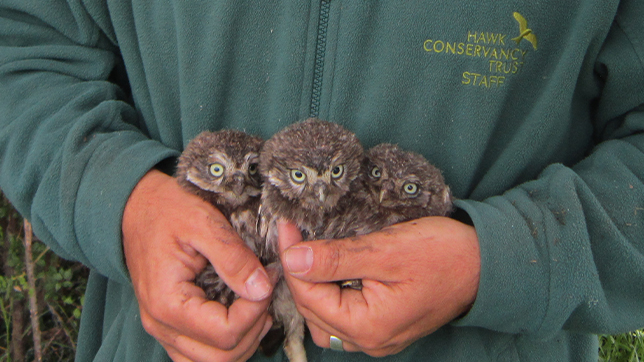10th July 2024
Currently, nearly one in six species in the UK are threatened with extinction. Which means the time to take action to help our incredible wildlife is now.
Thankfully, whether you’re surrounded by the bright lights of a city or patchwork countryside, you have the power to rewrite the story of local wildlife. As part of our ‘Tails’ of UK Wildlife campaign, we’re exploring the many ways you’re able to nurture the nature in your neighbourhood, for the benefit of biodiversity.
The Hawk Conservancy Trust are kindly sharing their top tips for supporting birds of prey in the UK! Read on, to discover what you can do to make a difference today…

1 – Avoid using rat poison
Rodents, like rats, are often seen as a pest by the people they encounter. However, rats are actually an important part of local ecosystems, because they’re consumed by other species, including birds of prey.
Traces of rodenticides (rat poisons) have been found in the vast majority of UK birds of prey. Unfortunately, even a trace of rat poison has a negative impact on birds of prey, whose chances of survival are affected – leading to a decline in numbers.
In place of using toxic substances to control rat populations, an alternative is to use a humane trap and release the rodent at a safe location, away from your home or business.
2 – Don’t chop down mature trees
Mature trees (ones that are close to their full height) host a huge diversity of species, by providing a food source and habitat for invertebrates (e.g. insects), birds, and small mammals. Additionally, mature trees provide a home for birds of prey.
Owing to their vital role in helping to highlight the health of ecosystems, it’s essential birds of prey can access mature trees that provide shelter for nesting and breeding.
As well as providing potential nesting sites for cavity-nesting birds of prey, standing dead trees are also important because they host vast numbers of invertebrates.
3 – Keep ivy
When ivy is growing around the trunk of a tree (and not preventing a tree’s leaves from getting sunlight), it offers fantastic nesting opportunities for birds! The nectar provided by ivy is attractive to bees and other pollinators, whereas the berries it produces are a crucial food source for birds during the winter. So, ivy encourages the creation of a healthy food chain for birds of prey.
4 – Put up small bird boxes
Our urban environments often create a shortage of nest sites for birds, which, in turn, lowers the number of small birds and impacts bird of prey. By setting up small bird boxes, you’re giving small birds somewhere to call home and helping to control species that could pose a risk to human health.
A healthy population of small birds helps to create an ecological balance, lessening the threat to birds of prey and other important species.
At the Hawk Conservancy Trust, they’ve installed and manage over 1,500 nest boxes for four UK bird of prey species, including the tawny owl, little owl, barn owl, and kestrel!
5 – Let gardens grow
Overly tidy gardens limit the space available for wildlife. So, letting your garden grow a little wild – even a tiny corner of it! – can gift opportunities for invertebrates, birds, and mammals to thrive.
Consider adding native species of plants and flowers (e.g. honeysuckle and pansy), to reduce the carbon footprint caused by travelling non-native species, while boosting populations of local wildlife, too.
Providing plenty of opportunities for invertebrates, birds, and mammals in your garden can help to support a healthy food chain for birds of prey and other wildlife species.
6 – Remember that red kites don’t need feeding
Although they’re an incredible success story for what can be achieved through conservation work, red kites might develop unwanted behaviours (e.g. approaching humans) should you start feeding them. If red kites learn to rely on people for their food, they’re likely to put themselves at risk of harm.
Instead of feeding red kites, enjoy watching them soar through the sky!
Interesting fact(s): Red kites are harmless to people and pets – plus, they don’t have a negative impact on the number of buzzards and kestrels.
7 – Celebrate birds of prey
Due to their status as apex predators (at the top of a food chain), birds of prey regulate the numbers of prey species to maintain balance in local ecosystems. For example, if you’re seeing a lot of sparrowhawks, barn owls, or red kites in your neighbourhood, that usually means there’s a healthy population of small birds, field voles and invertebrates.
Interesting fact: Birds of prey who don’t feed on carrion (dead animals) tend to target weaker individuals, keeping the populations of prey species healthier!
Being aware of birds of prey living in rural and urban areas can generate an enormous sense of wellbeing. There are so many opportunities to enjoy watching birds of prey – for instance, even in urban areas, you might spot peregrine falcons nesting in church towers!
Are you searching for more ways to support local wildlife? If so, visit our articles all about creating wildlife-friendly spaces and attracting wildlife to your garden safely as a pet owner.
